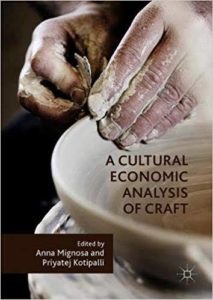A new book on craft is an excellent resource for those working in cultural policy across the wider world.
 Anna Mignosa, Priyatej Kotipalli, ed. 2019. A Cultural Economic Analysis of Craft. Cham, Switzerland: Palgrave Macmillan.
Anna Mignosa, Priyatej Kotipalli, ed. 2019. A Cultural Economic Analysis of Craft. Cham, Switzerland: Palgrave Macmillan.
There is a research group at Erasmus University, Rotterdam which provides an important forum for craft policy. The book, A Cultural Economic Analysis of Craft, demonstrates the broad relevance of its work in the wider world.
The opening chapter by Ronda L. Brulotte and M. J. R. Montoya on the “Orange Economy” reflects recent thinking about creative industries as a source of future economic growth in a world of diminishing physical resources. Indrasen Vencatachellum shares his extensive experience at UNESCO by detailing the important events and concepts that have shaped international cooperation. As previously published in Garland, Priyatej Kotipalli shares the results of his PhD on the broader value attached to craft. And Anna Mignosa offers an important argument about the “externalities” of craft that are not always evident in conventional economic research.
This book has an extraordinary global overview of craft policy. Lili Jiang’s chapter on China includes important information about the value of craft in the development of the socialist state. I was particularly charmed by the activities of Handwerk featured in Thora Fjeldsted’s chapter on Germany, particularly this 2010 television advertisement
Simon Ellis and Joseph Lo reflect on the importance of “eco-localism” in the Asian context. More specifically, Ashoke Chatterjee offers a useful history of the development of policy in India, particularly the UNESCO Symposium on Asia-Pacific Creative Communities in Jodhpur, 2005.
The wildcard for me is the chapter on materials by Maikel H. G. Kuijpers. His argument about the need to re-focus on materials in our understanding of craft through a Universal Declaration of Material Rights. is particularly challenging. Is this the future? Looking at the recent activity of the Chinese Lacquer Alliance, I imagine a future volume explicitly on this subject.
This is an essential publication for all those involved in craft policy as well as historians of modern craft. It reflects the enormous work done by individuals and organisations to ensure that crafts remain key to our experience of culture.
The final word should go to Mahamadhai, a bandhani artist quoted by Judy Frater in her chapter on education for artisans:
“Art is the first time, craft is thereafter.”


Comments
A very interesting work. Many of the themes are ones that I took up in my book “Cultural Commodities in Japanese Rural Revitalization: Tsugaru Nuri Lacquerware and Tsugaru Shamisen” (Brill 2010). While I also developed my thesis using cultural economics, I was also very focused on aspects of local policy—as opposed to national policy—as related to crafts and how policy can determine the fate of highly place-based crafts, often in unexpected, if not counterintuitive ways. Interestingly, when the scope is widened to include cultural performances as well as culture-based craft—as I did in my research—assumptions are often wrong and the different trajectories are quite surprising.